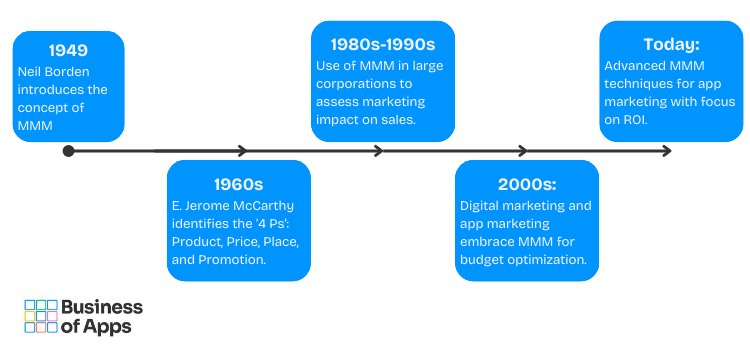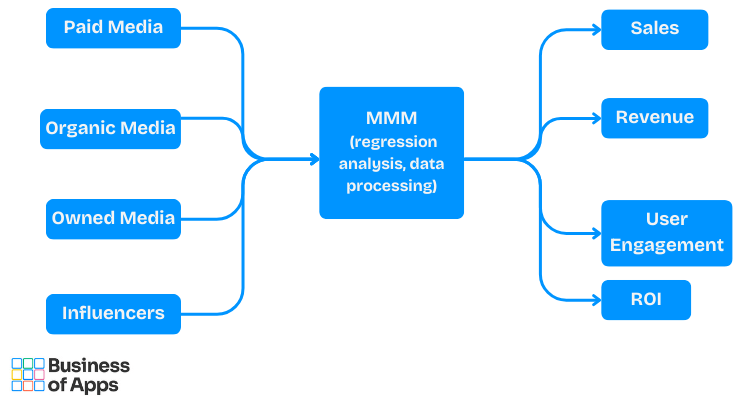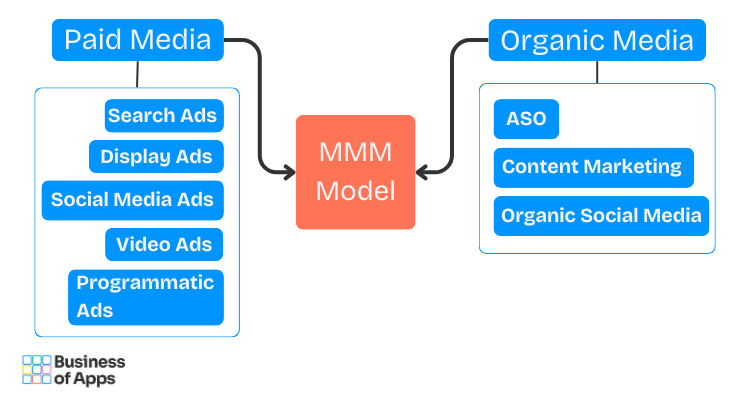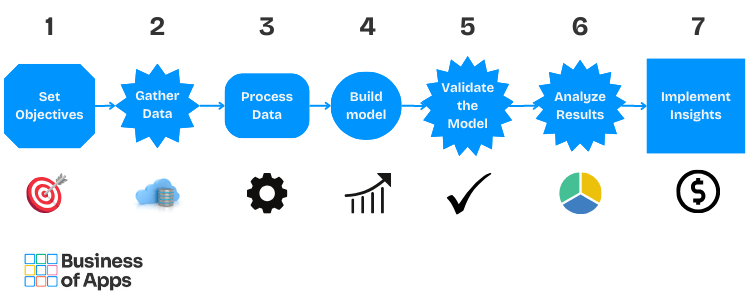Definition
Marketing Mix Modeling (aka MMM) is a forecasting methodology used by marketers to assess the impact of various app marketing tactic scenarios on product sales. To build a Marketing Mix Model, marketers use statistical models, such as multivariate regressions, as well as sales and marketing time-series data. The most common use of MMM is to optimize a mix of advertising techniques and promotional tactics with respect to sales, revenue, or profit to maximize ROI.
Among the benefits that MMMs bring to the table is the ability to calculate the gap between the moment potential app users were shown ads and actions taken thanks to those ads. Also, they allow marketers to account for advertising’s diminishing returns over time, calculate the scale of product cannibalization and halo effect. Marketing Mix Modeling is an undervalued asset among other app marketers can use, and so let’s take a look at its history and significance.
The term Marketing Mix Modeling was introduced by Neil Borden in 1949 as a concept of marketing mix. Essentially, it was defined as the set of variables that the company can change to meet their clients needs. The Marketing Mix “ingredients” were identified by E. Jerome McCarthy as the four P’s:
- price
- promotion
- product and
- place (distribution)
All four are applicable to mobile apps and provide the basis for app marketers to build a MMM for apps they promote.
The evolution of Marketing Mix Modeling
Source: Business of Apps
Today’s app market is highly saturated, the most of app users’ needs are met with multiple apps. A quick search on the App Store or Google Play will give you dozens of apps to choose from. In this environment, it is really hard to grow a mobile app’s user base using one or two app marketing techniques. The situation demands applying such a comprehensive marketing technique as Marketing Mix Modeling. In this next chapter, we will dive deeper into why app marketers’ need to pay close attention to it.
App Marketing Buyer's Guide
Download our App Marketing Buyer’s Guide to learn how app marketing works, what mobile app marketers do, the best app marketing strategies, how much it costs, and, of course, the top mobile app marketing companies to hire for your app’s promotion.
Why app marketers should care about MMM
In app marketing, typically any decision impacts not one or two but up to tens of million of users or more. The App Store app distribution model pioneered by Apple in 2008, with its low price tag for a mobile app’s copy, demands building a large user base for an app. Therefore any decision app marketers make on what ad creatives to use for an ad, what audience segment to approach and when have implications. To make these decisions efficiently, marketers need lots of data points. Mix Marketing Models present a framework for utilizing that data to inform their decisions.
Marketing Mix Modeling helps to optimize marketing spend and strategy by analyzing effectiveness of different marketing channels and assessing their impact on business outcomes. Let’s break down into its constituents the help MMM brings. First of all, the model helps to analyze contribution of different marketing channels into the general business outcome (email versus social media versus paid ads, and so on). Once such channels are identified, the model helps to allocate marketing budget to those resources properly.
How MMM Optimizes App Marketing
Source: Business of Apps
The next “ingredient” – identifying channels that bring diminishing returns and hence one needs to stop using them. The next up is short-term vs. long-term analysis that helps to balance app marketers actions between short-term promotions and log-term brand-building efforts. The final two crucial ingredients are assessing an impact of external factors and cross-channel effects of different marketing channels. This is how MMMs help to optimize marketing spending. It’s time to talk about the components of a Marketing Mix Modeling.
Core components of Marketing Mix Modeling
Media inputs
Media inputs, used by app marketers to calculate a Marketing Mix Model, can be attributed to one of the eight buckets:
- Paid media
- Organic Media
- Owned Media
- Influencer Marketing
- Partnership and Affiliates
- TV and Radio ads
- Out-of-home
- Referral programs
Let’s review all of these briefly, starting with the Paid media inputs.
Paid media
The full list of inputs that app marketers attribute to Paid Media include Search Ads, Display Ads, Social Media Ads, Video Ads, and Programmatic Ads. The major Search Ads platforms available to marketers are Apple’s Search Ads and Google Ads. The former allows iOS app owners tap into app users direct intent to find and install iOS apps that serve specific function and the latter allows the same for the Android OS. Both platforms allow to target specific audiences based on search queries people use when they search for apps. Display Ads inputs present data gathered with a banner ad campaign and usually expressed with such data points as Cost Per Click, Cost per Install and Conversion Rate.
Another kind of Paid Media inputs generated by Social Media Ads – highly targeted text and graphic ads that are run on such platforms as Meta’s Facebook Ads, Google Ads, Reddit, Pinterest, X, and LinkedIn. Next up, are some of the today’s most effective types – Video ads and the brightest examples of which are TikTok, Instagram and YouTube Ads. Finally, Programmatic Ads, advertisements sell and bought through real-time bidding system, are run on such ad networks as AppLovin, Vungle, ironSource and other small advertising networks. With these ads, app marketers can automate the entire process of running their ads in many other similar or complimentary apps. Paid Media inputs represent the most common kind of MMM media inputs and require automation to calculate their impact on its calculations.
Having said that, Paid Media inputs are often complimentary to Organic Media and so let’s switch gears to review the latter.
Media Inputs for MMM: Paid vs. Organic Media
Source: Business of Apps
Organic media
On a contrary to Paid Media, Organic Media inputs cover marketing methods that usually either require much smaller investments or none at all. In app marketing, Organic Media inputs are App Store Optimization (ASO), Organic Social Media (engaging with the app’s audience on social media platforms without paid promotions), and Content Marketing (includes creating text, photos, video content that represent the app’s brand and posted on a blog or third-party media publications). All three components often overlap and work in concert amplifying each other’s impact.
The next type of Media Inputs is similar to Organic Media but limited to digital assets that are under fool control of an app’s brand.
Owned media
Owned Media includes channels like a company’s website, blog, email lists, mobile app, and social media profiles. Unlike Paid Media (ads) or Earned Media (like PR mentions), owned media allows a brand to shape its messaging and engage directly with its audience without outside influence. Compared with other kinds of Media Inputs, Owned Media gives the brand a full control over the content, design and messaging via marketing channels. It’s cost-effective, since it doesn’t involved expenses on advertising, and it’s a long-term asset – it gives a brand a sustainable way to engage with the current and future customers, without extra costs. Examples of Owned Media include email marketing, push notifications, website / blog, and social media pages.
Moving on, from digital assets that are under full control of a brand to Influencer Marketing that is based on generating content for the app’s promotion by one of more influencers.
Influencer marketing
Influencer Marketing is based on paid or organic partnerships with influencers to promote the app to their followers through content like tutorials, reviews, contests, sweepstakes, and more. The most common example of an influencer marketing campaign is when an influencer reviews a mobile app in front of a camera, essentially give it a demo for her followers. Thanks to the level of trust influencers enjoy with the followers, they manage to persuade their followers to try the app themselves. Compared with Paid and Owned Media, Influencer Marketing inputs are harder to measure but it has established itself as a really effective way of a mobile app’s endorsement.
Partnerships and affiliates
Partnerships and Affiliates – the media inputs that contribute MMM calculations with data points generated via app brands partnering with other apps or brands. The difference between the two lies in the fact that affiliation implies revenue sharing and partnership does not. In both cases, app markers reach out other app brands that a complimentary to their apps to leverage the Venn Diagram of the apps’ audience interests and needs. In practice, a partnership between two apps can imply using multiple marketing channels for cross-promotion. The concept of partnering or affiliation with other brands is widely accepted in marketing and it’s also true for app marketing.
Next up are media inputs generated via TV and Radio ads.
TV and radio ads
Despite the prevalence of digital media as major Media Inputs, advertisements on TV, including CTV, and radio are still in a mobile app’s marketing toolbox. A fresh example of a TV run for a mobile app is the budgeting and financial management app Rocket Money commercial from October of 2024. The TV ad explains to the audience how the app can be used to manage subscriptions effortlessly and save money via the app. Given high pricing of ads on TV and radio, these channels often used for big app launches or mass awareness.
And finally, the oldest type of advertising that is also a part of MMM calculations – Out-of-Home ads.
Out-of-Home (OOH) ads
OOH ads include various kinds of physical ads such as billboards, digital kiosks and other physical advertising used to drive app awareness. A familiar example is a banner ad that greets people arriving to an airport, which is intended to introduce people to an app that has a high local significance. Because digital advertising landscape is so crowded, using physical ads allow app marketers to breakthrough the noice and brand their apps for the audience.
As important media inputs are, they are always accompanied by non-media inputs, let’s take a look at them as well.
Non-media inputs
Non-media inputs include such external factors as economic trends, weather, seasonality. By economic trends we mean changes in a region, country or group of countries economy that force people to spend less or more money on goods and services, mobile apps included. Sudden changes in weather may lead to canceling certain events, which subsequently leads to increase or decrease in use of certain mobile apps. Seasonality usually manifests in how much people travel and sales in increase for all services involved, which impacts on the number of traveling apps downloads and generated revenue. Non-media inputs are often overlooked by app marketers but they are important data inputs that impact MMMs calculations.
Pricing, as well as promo campaigns, are yet another variables that should be factored into Marketing Mix Modeling calculations. The expected financial outcome of a particular MMM depends on how much each sale generates. For paid apps the pricing typically ranges from $1.00 to $10.00 per copy, app subscriptions range anywhere between $10 and $100 / month. Promotional campaigns, dedicated to specific holidays, the end or begin of a season and so on, imply a temporary price drop to incentives potential customers to buy a copy or subscribe to an app.
A good example of an app’s price change and its impact on generated revenue is the introduction of the Basic with Ads ad-supported plan by Netflix. In November 2022, the company launched a cheaper plan that implied showing ads to subscribers, in the movies they watch, and them paying only $6.99 against $9.99 with the Standard plan. The introduction of this plan had a notable impact on its revenue and subscriber growth in the fourth quarter of that year. The company reported a 12% revenue increase, reaching $8.83 billion, largely driven by subscriber growth due to the new tiered pricing structure.
Finally, changes for an app product also impact app users’ experience with the app, their sentiment about it and subsequently their with to spend more or less money on it. To illustrate this point, we can look at the 2017 Snapchat interface design change. That change brought devision of the UI into two sections – one for social interactions and another for media content. The backlash that this change caused from its user base cost the company significant stock prop by $1.3 billion.
Having all Media and Non-Media Inputs covered, let’s move on to the notion of Response Variable.
Response variable
In Marketing Mix Modeling, Response Variable represents the major outcome that is expected as the result of all marketing methods applied.
It can be an increase in:
- sales
- revenue
- app installs
- brand awareness
- customer engagement in general
Defining a response variable for a particular MMM calculation is always driven by a business goal. For instance, if a business goal is to increase mobile app users engagement then the response variable would be increase in user sessions or in-app purchases. Usually, Marketing Mix Modeling has a single response variable but complex models may have several. The efficiency of correlation between a business goal and response variable is defined by data quality and granularity. It’s important to remember and factor in a lagging effect because some marketing activities may not lead to an immediate impact and that delay needs to be incorporated into a MMM calculations. The response variable can be influenced by non-marketing factors, such as economic conditions, seasonality, and competitor actions.
Moving on the next notion that is important in Marketing Mix Modeling – Time Frame.
Time frame
In MMM calculations, a time frame refers to the period of collecting and analyzing data to measure the impact of marketing activities on business outcomes. Selecting an appropriate time frame is crucial to the calculations accurately and relevance of the model’s insights. A time frame attributes are length, data granularity, lagged effects, seasonality, and campaign duration. Generally speaking, it’s always adjustable to err on the side of a longer time frame – it provides more comprehensive view of marketing impacts. Defining an optimal time frame for a MMM is essential for striking a balance between capturing detailed, actionable insights and avoiding excessive data complexity that may lead to errors or inability to calculate a particular MMM altogether.
Time Frame is the final component on the list for a Marketing Mix Modeling, now let’s see how MMM actually works.
How Marketing Mix Modeling works
Let’s begin with data collection. This process involves gathering and analyzing data sources to assess the impact of marketing activities on mobile app installs, user engagement, and generated revenue. Given the Media Inputs we’ve listed and reviewed previously, the process can be breakdown to Paid and Owned Media channels data analysis that factors in data from digital ads, in-app advertising and affiliate and influencer marketing. It also involves collecting data for app users engagement and retention metrics to include data points from ASO, website / blog and social media. App user engagement and retention metrics are also have to be carefully collected for analysis. Eternal data, that consists of data points about the impact of seasonality, holidays, economic indicators, and competitors is also part of the mix.
App data attribution is yet another important aspect of data collection. For app marketing, it’s been a challenge to keep app install data attribution accurate, especially after the launch of Apple’s App Tracking Transparency framework. To ensure the accuracy of attribution, app marketers need to use unified attribution models implement tracking solutions that align attribution across different channels.
Now, let’s review what statistical techniques are being used by app marketers for Marketing Mix Modeling.
Statistical techniques
Marketing Mix Modeling (MMM) relies on a variety of statistical techniques to quantify the impact of different marketing inputs on business outcomes. These include Multiple Linear Regression, Hierarchical or Multilevel Modeling, Bayesian Regression. Distribution Lag Models, Time Series Analysis, and more. Each of these techniques provides different strengths and insights, and MMM often uses a combination of these approaches to get the most accurate, actionable results. Selecting the right statistical method depends on the nature of the data, the desired insights, and the complexity of marketing interactions.
Attribution and impact
Marketing Mix Modeling attribution is based on a historical analysis of data for multiple marketing channels to assess their contribution for achieving specific outcomes, such as app installs, in-app purchases, subscriptions, and more. By isolating each impact, it allows to show how much of each outcome can be attributed to individual marketing channels.
Part of the MMM attribution is calculating ROI for individual channels. By comparing revenues generated via each each channel, it’s possible to identify the most efficient ones, the ones that return diminishing returns and hence optimize budget allocation. MMM also distinguishes between short and long-term ROI, helping app marketers to build a proper marketing strategy.
Steps to build a Marketing Mix Modeling
Set clear objectives
Every Marketing Mix Modeling begins with identifying business goals and key performance indications (aka KPIs) to measure throughout the marketing campaign. By launching a mobile app, businesses can be after generating revenue, elevating their profile, reaching new audience to convert them to leads and ultimately to customers. Some of the standard KPIs that are used for MMMs in app marketing are CPC (Cost-Per-Click), CPM (Cost-Per-Mile), CPI (Cost-Per-Install), CPA (Cost-Per-Action), LTV (Life Time Value), ROAS (Return on Advertising Spend), and others. Settings clear business goals and KPIs to measure is essential for accurate Marketing Mix Modeling.
Gather data
The next step for Marketing Mix Modeling implementation is gathering data. Data inputs, that need to be gathered, are information about sales, generated revenue and marketing spend, it consists of internal and external data gathering. Internal data presented with sales, revenue, and marketing spend, external data – competition and marketing conditions. In app marketing, sales can manifest as app subscriptions, registrations, in-app purchases, freemium to premium upgrades, merchandise sales, paid app downloads, and more. Revenue generated with sales is money earned via in-app purchases or subscriptions, money made with in-app ads, affiliate marketing, sponsorship and branded content. The effectiveness of a particular MMM for an app business is a function of a quality of its data gathering efforts.
Steps to build a Marketing Mix Model
Source: Business of Apps
Data processing and cleaning
The process of building a MMM involves choosing the right tools and techniques, as well as testing and validating the model with historical data. Data processing includes addressing missing values, handling outliers, and aligning data from different sources. Missing values issues can be caused by ad platforms downtimes, issues with funding sources that lead to ad campaigns halts, and more. Data consistency is essential for accurate modeling.
Model selection and development
To quantify the impact of each marketing input on the response variable, app marketers should use statistical techniques such as multiple regression or similar methods. Among similar methods are Hierarchical or Multilevel, as well as the Bayesian one. This quantification should be adjusted for lagged effects and interactions among variables as needed. Brand campaigns are a good example of marketing activities that may have lagged effects. Incorporating lagged variables into a MMM allows app marketers to measure delayed impacts of channels like TV, which may cause sales boosts over weeks. Finally, MMM development involves also identifying carryover effects – a sustainable impact of a marketing input even after the campaign ends. Using these techniques allows to capture the complex dynamics between marketing inputs and business outcomes, making the model as accurate and actionable as possible for optimizing marketing spend.
To make sure the model will be efficient one needs to validate it and this is the next step.
Validate the model
To validate a MMM you need to test the model’s accuracy by comparing predictions against actual outcomes. Based on the testing, one needs to adjust the model to improve reliability. A typical MMM validation may include the following components – sample testing, cross-validation, predictive accuracy testing, insuring it’s stable over time, and more.
A classical example of cross-validation is comparing data from different app traffic sources. For instance, an app’s marketing team may want to measure the impact of different channels – such as organic search, paid search ads, social media ads, and traffic generated via influencer marketing campaigns. During the validation, one would need to have a data set divided into traffic source subsets. These subsets are used for training and testing, and ultimate cross-evaluation.
Essentially, the training is the process of generating predictions, based on the subset that misses one traffic source. These predictions then are tested on the omitted traffic source and compared to the actual data from this source. This process needs to be repeated for every single source used for a MMM building.
Such validation allows app marketers to assess effectiveness of a particular MMM, by testing it against with real-world variations in user behavior across all traffic sources used.
Analyze and interpret results
The subsequent phase in constructing a Marketing Mix Model entails assessing the contributions of each marketing channel, computing the Return-On-Investment (ROI), and identifying areas for enhancement. This step is essential for determining the most effective marketing channels to utilize based on their effectiveness, ROI potential, and subsequent optimization.
Implement insights
This is the final step in a process of building a MMM. On this step, app marketers apply findings to inform budget allocation and improve the marketing strategy. The key aspects of such insights implementation are resources reallocation based on ROI, channel optimization, creative adjustments. A typical example of resources reallocation is when App Store Optimization (aka ASO) delivers a strong growth for a mobile app and it is logical to shift resources from paid acquisition to ASO.
Also, part of MMM insights implementation is launching experiments with new channels. Channels with high potential are always need to be considered, especially if a MMM shows that related channels are effective. For example, if the data shows that Apple Search Ads do perform well, it makes sense to run an influencer marketing campaign to drive search interest.
By this step we’re concluding the listing of all steps that are necessary to build a Marketing Mix Model and proceeding to the benefits of MMMs.
Benefits of Marketing Mix Modeling
MMMs provide a number of benefits and the major ones look like the following.
Budget Allocation Optimization
Marketing Mix Modeling helps app marketers to allocate spend across multiple channels efficiently. Today, to run a successful and profitable app business one needs to use multiple marketing channels, without such modeling it’s impossible to use marketing budget efficiently. Efficiency of app marketing channels isn’t absolute, for some apps work one group of channels, for other apps – another group delivers results. For instance, a mobile app that serves a community of users should in theory be a good fit for an influencer marketing campaign. But this is merely a hypothesis, without running a test, one would jeopardize to waist a marketing budget, acting on a gut feeling.
Understanding Cross-Channel Effects
Another benefit that MMMs bring on the table is that they allow understand how different channels influence each other. Mobile apps have unique audiences and hence without modeling it is not feasible to assess how multiple marketing channels will impact each other efficiency. For example, using paid advertising via TikTok Ads can work with running influencer marketing campaign on the same platform really well for some app, but the same combination may be a really bad fit for another app. Marketing Mix Modeling allows marketers to check app marketing channels compatibility on an on-going basis and make sure they fit.
Data-driven decision-making
MMM provides marketing with more confidence in budget distribution. Raising money to build a mobile app and launch it on a market is complicated and making mistakes in allocating the app’s marketing budget can easily make such app business fail. Data-driven approach ensures app marketers have a clear picture of how to spend their budget on the app’s marketing campaign.
Adapting to Market Changes
There is a number of external changes that influence the app’s performance on a market, MMMs help marketers to adapt to these changes accordingly. All parts of the economy are interconnected, changes in a currency exchange may easily sway one way or another the app’s revenue potential. A good Marketing Mix Model is capable to account for known possible market changes to make the app’s revenue forecasting possible.
From benefits to limitations of the Marketing Mix Modeling, none of digital marketing methods is perfect and MMMs aren’t an exception.
Challenges and Limitations of Marketing Mix Modeling
Data Collection Issues
One of the key requirements for building a robust MMM is collecting consistent and granular data throughout the app’s marketing campaign. For certain app projects it can be a challenge and therefore collected data quality may vary, which leads to errors in MMMs.
Model Complexity
For certain app projects the number of variables in MMMs is sufficiently big to make it hard for understanding its statistical outcomes.
Time Lag in Results
MMM are a long-term optimization tool and therefore by definition they aren’t capable to provide a real-time analytical data. Certain data inputs used in Marketing Mix Modeling take time to collect and hence a time lag between the instances when these data points were generated and when its analysis was performed.
Tools and Technologies for Marketing Mix Modeling
There is a number of tools and technologies available for app marketing professionals to build a Marketing Mix Model. These include data collection and integration tools, statistical analysis and modeling software, visualization and dashboard tools, market4ing attribution and MMM-specific platforms, Machine Learning platforms, campaign management and data integration tools, ad networks and marketing analytics, and automation tool for MMM updates.
Examples of data collection and integration tools are companies like Adjust, AppsFlyer, and Branch, data visualization can be done with a help of tools like Looker, Microsoft Power BI and others. When it comes to marketing attribution the best choices are tools from Nielsen, Ekimetrics, Analytic Edge. Machine Learning platforms we suggest app marketers to use are Google Cloud AI, Amazon SageMaker, and Azure Machine Learning from Microsoft.
If you want to learn more about Marketing Mix Modeling, watch a workshop by Kochava’s General Manger, AIM, Gary Danks, where the talks about how to unleash app growth with the help of Marketing Mix Modeling.
Conclusion
Marketing Mix Modeling is a powerful tool with lots of benefits for app marketers to use. Among major benefits that MMMs bring to app marketers are more efficient app marketing budget allocation, understanding of cross-channel effects, decision-making based on hard data, ability to adapt to market changes quickly.
We suggest marketers to start small and then gradually scale their MMM efforts. The first step is to define a primary goal and select a few key channels to begin with. Once it’s done, proceed with gathering essential data, you may include your existing data as well. On this step, make sure you’re focusing on core metrics and choosing a simple model to work with. The underlining idea for these initial steps to validate the model in a short time frame and check accuracy with cross-validation.
The next step is to gradually add more channels and complexity to the model, using advanced tools for scaling such as dedicated MMM platforms and automated data pipelines. And finally, you need to refine your Marketing Mix Model with ongoing analysis with regular updates and expanding to long-term goals.









